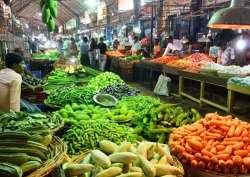Veggies, pulses drag inflation to record low of 2.18 pc in May
The CPI based retail inflation stood was at 2.99 per cent in April 2017. In May 2016, it was at 5.76 per cent. The overall food inflation was in negative territory at (-) 1.05 per cent during the month.

India's annual retail inflation eased to a record low of 2.18 per cent in May, and the country's factory output growth also marginally slowed to 3.1 per cent in April from 3.75 per cent during the month before, official data showed on Monday.
As per data released by the Central Statistics Office (CSO) on Consumer Price Index (CPI), retail inflation was dragged lower by a sharp fall in prices of pulses, cereals and perishable items. The current inflation rate is the lowest since the series began in 2012.
The May retail inflation rate fell even when compared with April, when it prevailed at a higher rate of 2.99 per cent.
According to the CPI data, the Consumer Food Price Index (CFPI) deflated as prices in May fell by (-) 1.05 per cent, as compared with a rise of 7.45 per cent in the corresponding month of 2016.
The other key macro-economic data released by the CSO -- Index of Industrial Production (IIP) -- showed that on a sequential basis, the output rose marginally slower than the revised estimates for March 2017.
The growth estimates for March 2017 were revised upwards to 3.75 per cent from 2.7 per cent.
However, on a year-on-year (YoY) basis, a healthy performance of the manufacturing sector accelerated April factory output to 3.1 per cent over the corresponding month of last year.
As per the new IIP series with revised base year of 2011-12, the expansion on a YoY basis was mainly on account of a 2.6 per cent rise in manufacturing output, which has the maximum weightage in the overall index.
Besides manufacturing, the output of other two major sub-indices -- mining and electricity -- too expanded during the month under review.
The mining output rose by 4.2 per cent and that for electricity generation edged higher by 5.4 per cent.
"In terms of industries, 14 out of the 23 industry groups in the manufacturing sector have shown positive growth during the month of April 2017 as compared to the corresponding month of the previous year," the CSO said in a statement.
Among the six big industry groups, the growth rates were 3.4 per cent in primary goods, 4.6 per cent in intermediate goods, 8.3 per cent in consumer non-durables and 5.8 percent in infrastructure or construction goods.
In contrast, the output of consumer durables declined by six per cent and was lower by 1.3 percent in capital goods.
As regards to inflation, data revealed that vegetable prices in May fell by 13.44 per cent, and pulses recorded a sharper drop of 19.44 per cent.
Food and beverages during the month under consideration recorded a marginal fall of (-)0.22 per cent over the same month last year.
Among non-food categories, 'fuel and light' registered the highest inflation rate of 5.46 per cent in May.
While the rural CPI in May ruled higher at 2.30 per cent, retail inflation in urban areas was at 2.13 per cent.
Reacting to factory output numbers, Assocham termed the latest estimates as a positive sign towards the growth cycle of industrial activity in India even "though it is not showing stability in growth".
"April 2017 IIP numbers state the optimistic outlook for the economy as it is evident through General Index which is 3.1 percent higher as compared with the level in the month of April 2016," Assocham said in a statement.
In a similar vein, Ficci's President Pankaj Patel said: "Overall the industrial growth seems to be stablising and could pick up momentum if global demand is steady in months to come. Industry is looking forward to forthcoming foreign trade policy review to further encourage manufacturing exports."
"A more accommodative monetary policy with lower interest rate would stimulate consumer demand that would hedge any downside risk arising from exports," Patel added.